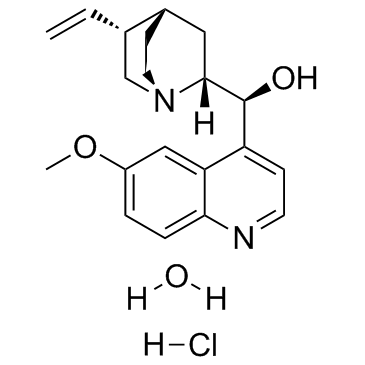Quinidine hydrochloride monohydrate |
| Catalog No.GC37062 |
Quinidine hydrochloride monohydrate is an anti-arrythmic agent which is also a potent blocker of K+ channel with an IC50 of 19.9 μM.
Products are for research use only. Not for human use. We do not sell to patients.

Cas No.: 6151-40-2
Sample solution is provided at 25 µL, 10mM.
Quinidine hydrochloride monohydrate is a clinical anti-arrythmic drug which is also a potent blocker of K+ channel with an IC50 of 19.9 μM. IC50: 19.9 μM (K+ channel)[1]
Quinidine hydrochloride monohydrate blocks WT mSlo3 (KCa5.1) channels with an IC50 of 19.9±1.41 μM and Hill slope of 1.15±0.15 (n=7). Again, the potency of inhibition by Quinidine hydrochloride monohydrate is higher for F304Y mSlo3 (IC50 of 2.42±0.60 μM, n=9, P<0.005; Hill slope of 0.98±0.12), but lower with R196Q mSlo3 (IC50 of 38.4±6.77 μM, n=5, P<0.001; Hill slope of 1.05±0.16). The inhibition of F304Y mSlo3 by Quinidine hydrochloride monohydrate is observed to have some time dependence[1].
Direct application of Quinidine hydrochloride monohydrate on the sciatic nerve produces a dose-related decrease in amplitude at ascending somato-sensory evoked potential (SSEP) and descending compound muscle action potentials (CMAP) when comparing baseline with other time points, or when comparing the experimental left limb to the right contra-lateral glucose-treated limb. The latencies of SSEPs and CMAP potentials after Quinidine hydrochloride monohydrate applications are increased compare to baseline and the contralateral side[2].
[1]. Wrighton DC, et al. Mechanism of inhibition of mouse Slo3 (KCa 5.1) potassium channels by quinine, quinidine and barium. Br J Pharmacol. 2015 Sep;172(17):4355-63. [2]. Cheng KI, et al. Application of quinidine on rat sciatic nerve decreases the amplitude and increases the latency of evoked responses. J Anesth. 2014 Aug;28(4):559-68.
Average Rating: 5 (Based on Reviews and 38 reference(s) in Google Scholar.)
GLPBIO products are for RESEARCH USE ONLY. Please make sure your review or question is research based.
Required fields are marked with *




















